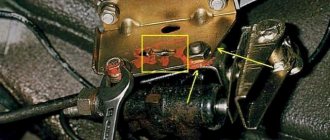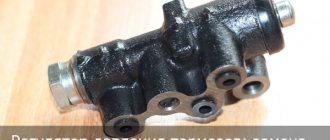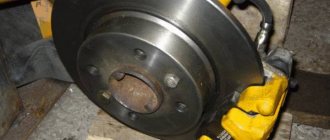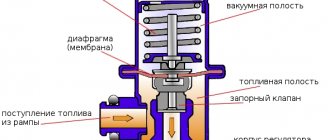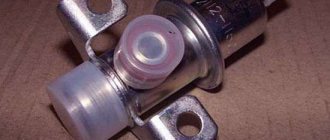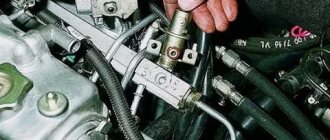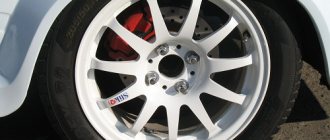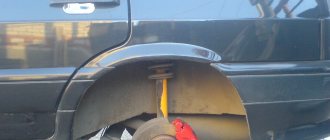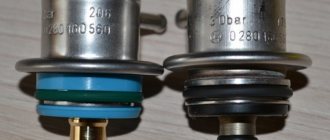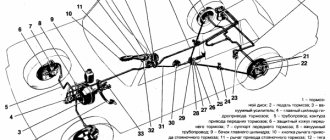A brake force regulator, or sorcerer in common parlance, is a mechanical device designed to relieve excess pressure in the rear drum brakes.
On VAZ-2109, VAZ-2108, VAZ-2114 and other front-wheel drive models produced in Togliatti, it was installed in the rear left part of the body, under the bottom, in front of the rear suspension beam. The brake pressure regulator on the VAZ-2107 model and other “classics” is located on the right in the direction of travel of the car.
New vehicles equipped with ABS and EBD do not use the sorcerer.
checking and adjusting brakes on VAZ 2110 VAZ 2111 VAZ 2112 cars
Checking pipelines and connections To prevent sudden failure of the brake system of the VAZ 2110, VAZ 2111, VAZ 2112, carefully check the condition of all pipelines and connections, paying attention to the following: metal pipelines should not have nicks, scratches, burrs, active foci of corrosion and should be located away from from sharp edges that can damage them;
brake hoses must not have any cracks on the outer shell or signs of chafing visible to the naked eye; they should not be exposed to mineral oils and lubricants that dissolve rubber; by pressing the brake pedal firmly, check to see if any swelling appears on the hoses, indicating their destruction; all pipeline fastening brackets must be intact and well secured; loosening or destruction of brackets leads to vibration of pipelines, causing their breakdowns; Do not allow fluid to leak from the connections of the master cylinder with the tank and pipelines; if necessary, replace the tank bushings and tighten the nuts without subjecting the pipelines to deformation. When tightening the pipeline nuts, use the wrench 67.7812.9525. Eliminate any detected faults by replacing damaged parts with new ones. Flexible hoses, regardless of their condition, should be replaced with new ones after 125 thousand kilometers or after five years of operation of a VAZ 2110, VAZ 2111, VAZ 2112 to prevent sudden ruptures due to aging.
Checking the functionality of the vacuum booster VAZ 2110, VAZ 2111, VAZ 2112
Press the brake pedal 5-6 times with the engine off to create equal pressure close to atmospheric in cavities A and B (see Fig. 6-2). At the same time, by the force applied to the pedal, make sure that the valve body is not jammed. Keep the brake pedal depressed and start the engine. If the vacuum booster of the VAZ 2110, VAZ 2111, VAZ 2112 is in good working order, the brake pedal should “move forward” after starting the engine. If the brake pedal does not “go forward”, check the fastening of the hose tip, the condition and fastening of the tip flange in the booster, the hose to the tip and the fitting of the engine intake pipe, since loosening the fastening or their damage sharply reduces the vacuum in cavity A and the efficiency of the booster.
rice.
6-2. Vacuum booster: 1 - vacuum booster housing; 2 — amplifier housing cup; 3 - rod; 4 — adjusting bolt; 5 — rod seal; 6 — sealing ring of the main cylinder flange 7 — diaphragm return spring; 8 — amplifier pin; 9 — tip mounting flange; 10 - valve; 11 — hose tip; 12 - diaphragm; 13 — amplifier housing cover; 14 — sealing cover; 15 - piston; 16 — protective cover of the valve body; 17 — air filter; 18 — pusher; 19 — pusher return spring; 20 — valve spring; 21 - valve; 22 — valve body bushing; 23 — rod buffer; 24 — valve body; A - vacuum chamber; B - atmospheric chamber; C, D - channels Adjusting the brake drive of VAZ 2110, VAZ 2111, VAZ 2112
The free play of the brake pedal when the engine is not running should be 3-5 mm. The adjustment is carried out by moving the brake light switch 7 (Fig. 6-11) with nut 6 released. Install the switch so that its buffer rests against the pedal stop, and the free play of the pedal is 3-5 mm. In this position of the switch, tighten nut 6.
rice.
6-11. Brake drive: 1 — master cylinder; 2 - tank; 3 - vacuum booster; 4 — brake pedal bracket; 5 — brake light switch buffer; 6 — brake light mounting nut; 7 — brake light switch; 8 - brake pedal WARNING Adjust the free play of the brake pedal when the engine of the VAZ 2110, VAZ 2111, VAZ 2112 is not running. If the brake light switch is too close to the pedal, it does not return to its original position.
In this case, valve 21 (see Fig. 6-2), pressing against body 24, separates cavities A and B, which opens air access to chamber B, and the wheels are incompletely released when the pedal is released. If moving the brake light switch cannot eliminate the incomplete release of the brake mechanisms, then disconnect the brake master cylinder from the vacuum booster and check the protrusion of the adjusting bolt 4 relative to the mounting plane of the master cylinder flange (size 1.25-0.2 mm). This size can be set by holding the end of the rod with a special wrench, and with another wrench, tightening or unscrewing bolt 4.
Is it worth removing the sorcerer (back-drum) (Your opinion is very important, colleagues)
Regular
And yet, he can remove the sorcerer and install a tee, like in the good old days on Soviet cars. Well, the rear brakes are bad. I installed new Bendix pads, replaced the brake fluid (every 2 years! - not lazy after all), the drums are at the limit, but not critical - 230 mm. (New 231mm on my model). Still, the brakes are rather dull for such a car, and apparently, as a result of the lack of efficiency, the rear overheats in the front. I know that removing the regulator is a controversial issue. So I want to see: who is “FOR” and who is “AGAINST”. By the way, if anyone knows where in Moscow you can buy a tee instead of a sorcerer, please give me a tip.
The purpose of the sorcerer
Where is the oil pressure sensor on the Kamaz
? The so-called sorcerer on the VAZ-2109 is necessary to automatically change the fluid pressure in the rear brake cylinders depending on the load acting on the car when the speed decreases. This element is used in both hydraulic and pneumatic drive systems.
The main purpose of changing the pressure is to prevent possible wheel locking and skidding of the rear axle of the car.
In some car models, in order to maintain their controllability and stability, a regulator is additionally installed in the brake drive of the front wheels.
In addition, on the VAZ-2109 the sorcerer is used to increase the braking efficiency of an empty car. The traction force of a loaded car and an empty one is different, so the force on different axles must be adjusted. In the case of a loaded and empty machine, static type regulators are used. Automatic solutions are installed in trucks.
In sports cars, manufacturers often install a screw adjuster. It is located inside the car and adjusts the balance of the brake system directly during the race. It is adjusted based on weather conditions, road conditions, and tire quality.
"CHEVROLE-NIVA"
By the way, before testing tires on cars without ABS, each time we slightly adjust the regulator taking into account the road condition (snow, ice, asphalt), ensuring that the rear wheels lock a little later than the front ones. Let's not break tradition. Our Shniva found the gap between the cheeks of the regulator to be 16 mm, which was adjusted using a stop screw.
Several brakings, and the braking distance from 80 km/h for a car with a partial load is determined: 34.4 m. With a full load... 33.6! Almost a meter shorter! At the same time, the driver noted a heavier pedal and rapid heating of the brakes, which required cooling before each measurement. Let’s remember these parameters and make adjustments to the “sorcerer” adjustment. First, let's reduce the gap to 8 mm. Now the regulator significantly limits the pressure in the rear brakes, transferring almost all the hard work to the front ones.
Braking has become more difficult, keeping the front wheels from skidding is not so easy - they lock very sharply and the car, naturally, loses control. However, the result, to our surprise, is the same as in the basic version: 34.4 m. At full load, you have to press the pedal much harder, the front brakes begin to overheat. The result is 37.8 m. This is 4.2 m more than with the basic adjustment (33.6 m).
Basic faults and brake repair options
KamAZ GTK for cab
The best fix is prevention. When operating the VAZ 2108, it is necessary to strictly adhere to the scheduled maintenance periods for the brake system. This applies to the friction linings of the front disc and rear drum brakes. Complete wear of the friction linings threatens unexpected brake failure in an extreme situation. Periodically check the condition of the linings, monitor their level of wear, and replace if necessary.
Carefully monitor the brakes of the VAZ 2108 in terms of fluid leakage through worn gaskets and seals. Excessive wear of the sealing elements is fraught with the risk of insufficient force in the brake cylinders, failure of the pedal when driving the VAZ 2108, and an increase in the braking distance. All this creates very serious risks. Brakes are a critical safety system for drivers, passengers and other road users.
"LADA KALINA"
We set the regulator so that the rear is slightly late in locking the wheels. With this setting and partial load, the car needed only 27 m to stop. Fully loaded - 29.5 m. There are slight difficulties in preventing the front wheels from skidding. We reduce the gap in the regulator to zero - the half-empty Kalina stops after 31.8 m. The braking distance increases by 4.8 m, accompanied by a sharp blocking of the front wheels. The loaded one slows down after 35.2 m, the deterioration is even greater - 5.7 m! The pedal effort is increased and the brakes become noticeably hot.
How to check and adjust
Brake cleaner
If during the braking process the car slows down ineffectively, the car is pulled in one direction, the car often skids, then this is a signal that you need to check the unit and adjust the sorcerer on the VAZ-2109.
To check, the car is driven into a pit or overpass. Defects will be detected visually. Most often, the inspection shows that repair is not possible.
If we talk about adjustment, it is better to do it on an overpass. The adjustment greatly depends on the position of the body. Adjustments must be made after each maintenance. Adjustment is also necessary if something from the suspension has been changed. If there has been repair work on the rear beam or it has been changed, this also requires adjustment.
To adjust the device, use a wrench to slightly loosen the bolt securing the sorcerer to the lever. Then use a screwdriver to move the bracket until the gap allows you to insert a drill into it two millimeters. Next, the bolt needs to be tightened.
The regulator on the “ten” and previous models becomes very sour during the operation of the car. The bracket cannot be moved. In this situation, you can douse it with WD-40, and then use a hammer to move the part to the side.
Removal and installation
To replace the sorcerer on a VAZ 2110, you need wrenches 13 and 10. Instead of 10, a special wrench for brake fittings is very desirable; it is more gentle than a regular open-end wrench when handling soft copper nuts due to the large contact area.
Replacing a wheel bearing in a garage is not difficult if you have the necessary tools on hand. The work procedure is presented here: https://vazweb.ru/desyatka/hodovaya/zamena-stupichnogo-podshipnika.html
This type of wrench is similar to a socket wrench, but has a slot for inserting a tube into it and high jaws. You need about half a liter of brake fluid and 4 rubber plugs for the brake hoses.
RTD (sorcerer) Fenox
AvtoVAZ cast iron and Belarusian aluminum regulators are sold in VAZ spare parts stores. Russian VIS is usually more reliable, Belarusian Fenox is lighter and cheaper.
RDT (sorcerer) VIS assembled
The conditions under the bottom are unfavorable for the sorcerer, so you first need to clean the dirt with a stiff brush and moisten the threaded connections with a penetrating lubricant such as WD-40. The fixing bracket is removed from the rear beam; if necessary, you can use a powerful screwdriver to loosen it.
VAZ 2115 Checking and adjusting brakes
6.3.1 Checking and adjusting the brakes
Checking pipelines and connections Checking the functionality of the vacuum booster Adjusting the brake drive Adjusting the parking brake system Checking the functionality of the pressure regulator on the car Removing air from the hydraulic drive Replacing brake fluid
6.3.2 Checking piping and connections
To prevent sudden failure of the brake system, carefully check the condition of all pipelines and connections, paying attention to the following: – metal pipelines should not have nicks, scratches, rubs, or active foci of corrosion and should be located away from sharp edges that could damage them; – brake hoses must not have any cracks visible to the naked eye..
6.3.8 Replacing brake fluid
To ensure that no air gets into the hydraulic drive system when replacing the brake fluid and that a minimum amount of time is spent on this operation, adhere to the following rules: - proceed in the same order as when bleeding the brakes, but use a hose with a glass tube at the end, which you lower into a container with brake fluid; – while pressing the brake pedal, pump out the old brake...
The main task of regulators and the physics of braking
Why is the brake pedal on a VAZ 2110 tight?
The adhesion force of a car wheel to the road surface, like the friction force, is proportional to vertical loads. The proportionality coefficient is considered to be the coefficient of the tire's level of adhesion to the road. This value does not depend on the person in any way. It can be determined based on the condition of the road and tires. The higher the adhesion of the wheel to the asphalt surface during braking, the less will be And since when the pads operate, inertia also acts on the car, the vertical load on the wheels is redistributed. Therefore, the force on the disk should be uneven. The brake force regulator is also used to improve braking efficiency when the machine is not loaded. In this case, the traction force will be completely different than in the case of a loaded car.
Without a sorcerer
Knowing what the sorcerer's job is on the VAZ-2109, it is not difficult to guess what will happen if it is absent from the brake system. And the following will happen. The car will brake with all four wheels together. The wheels are blocked sequentially - first a pair of wheels on the rear axle, and then the front ones. The risk of an accident increases, since the driver moving behind is unlikely to react in time to a sudden maneuver. A collision will be inevitable.
A sorcerer in the car is very necessary. A VAZ-2109 car without a sorcerer can be very dangerous not only for others on the road, but also for the driver himself. This car is practically uncontrollable in a skid.
Only those who know exactly and understand well what they will get in the end remove the sorcerer. This is mostly done by professional racing drivers.
But some car owners still remove the sorcerer. At the same time, there are even claims that the car began to brake faster and better. Experts say it only seems so. In fact, everything is a little different. The problem here is that in the event of sudden braking, both pairs of wheels will jam in succession.
Adjustment
The work of the sorcerer on VAZ cars depends on the position of the body. Therefore, adjustment must be performed not only during each maintenance, but also when replacing shock absorbers and springs, after repairing the rear beam and, of course, replacing the sorcerer itself.
The car is placed on an overpass or inspection hole, to set the suspension to a balanced position, the trunk is rocked a couple of times by hand. Use a 13mm wrench to loosen the fastening bolts to the bracket; the front bolt is not visible from below, you need to find it by touch.
By moving the regulator, a gap of 2 mm is achieved between the elastic plate (the rod rests against it) and the lever. The spring resistance is high, you need to use a “mounter” or a special device. The bolts are tightened and the gap is checked with a feeler gauge. If you don’t have a probe, you can use a drill with a diameter of 2 mm and even a two-ruble coin.
Further verification is carried out on the fly. When braking from a speed of 40 km/h, on your own or with the help of a partner outside the car, evaluate the moment when the rear mechanisms begin to operate in comparison with the front ones.
If it needs to be done later, then the gap must be increased, and if it is smaller, then, accordingly, reduced.
Checking the brake pressure regulator of VAZ 2114, VAZ 2115, VAZ 2113
/ / / / / We bleed the brakes of the Lada 2113 ourselves, check the brakes of the Lada 2115, the hydraulic brakes of the VAZ 2113, VAZ 2115, VAZ 2114.
Place the Lada Samara 2 car on a lift or inspection ditch, clean the pressure regulator and its drive parts from dirt.
Pressure regulator VAZ 2114: 1 – pressure regulator body; 2 – piston; 3 – protective cap; 4, 8 – retaining rings; 5 – piston sleeve; 6 – piston spring; 7 – body bushing; 9, 22 – support washers; 10 – sealing rings of the pusher; 11 – support plate; 12 – pusher bushing spring; 13 – valve seat sealing ring; 14 – valve seat; 15 – sealing gasket; 16 – plug; 17 – valve spring; 18 – valve; 19 – pusher bushing; 20 – pusher; 21 – piston head seal; 23 – piston rod seal; 24 – plug; A, D - chambers connected to the main cylinder; B, C - chambers connected to the wheel cylinders of the rear brakes; K, M, N - gaps
Pressure regulator drive VAZ 2115: 1 – pressure regulator; 2, 16 – pressure regulator mounting bolts; 3 – bracket for the pressure regulator drive lever; 4 – pin; 5 – pressure regulator drive lever; 6 – axis of the pressure regulator drive lever; 7 – lever spring; 8 – body bracket; 9 – pressure regulator mounting bracket; 10 – elastic lever of the pressure regulator drive; 11 – earring; 12 – earring bracket; 13 – washer; 14 – retaining ring; 15 – bracket pin; A, B, C - holes
By external inspection, make sure that the pressure regulator of the Lada Samara 2 and its drive parts are not damaged, there is no leakage of brake fluid, plug 24 is recessed into the housing hole by 1–2 mm, there is no play in the connection of the earring 11 with the elastic lever 10 and the pin 15 of the bracket. Ask an assistant to press the brake pedal of the VAZ 2114, VAZ 2115, VAZ 2113. At the same time, piston 2 should move out of the body by 1.6–2.4 mm, compressing the leaf spring 7 until it stops against lever 5. Lever 5, overcoming the force with side of the elastic lever 10, will rotate relative to pin 4. Non-compliance with the listed requirements, lack of piston stroke, as well as its insufficient or excessive stroke indicate a malfunction of the regulator or its drive. In this case, repair or replace the pressure regulator, and after installing it, adjust its drive (see subsection “Adjusting the VAZ 2113 pressure regulator drive”).
- —
Checking pipelines and connections of the brake system of VAZ 2114, VAZ 2115, VAZ 2113
—
—
—
—
—
—
Replacing brake fluid
Replacing brake fluid VAZ 2114, VAZ 2115, VAZ 2113
Operation and repair of the brake system of the Lada 2113. Checking the regulator, cylinder, brake booster of the Lada 2114. Maintenance of the front and rear brake mechanisms of the Lada 2115.
Examination
The operation of the VAZ-2109, 2110 and other AvtoVAZ models is checked on the move, in closed areas. To do this, accelerate the car to a speed of 40 km/h and sharply press the brake. The rear wheels should lock 1/2 second later than the front wheels.
The wheels are monitored by an assistant located outside the car. If wheel locking occurs noticeably later or does not occur at all, and also if the rear axle is locked simultaneously with the front, the sorcerer adjustment procedure is repeated.
To increase the response time of the rear brakes, the gap between the adjuster and the bracket is increased; to shorten it, it is reduced accordingly.
What else is worth reading
Vacuum brake booster
Anti-lock braking system abs
Replacing brake pads VAZ 2110
Braking system on a classic
Why does the battery boil?
Brake force regulator device
It is mounted on a body bracket and connected on passenger cars to the rear axle beam via a rod and torsion bar. The second end of the last element acts on the regulator piston. The regulator input is connected to and the output is connected to the rear. The device is controlled by a drive connected to the rear beam. As for the design, the brake force regulator consists of a housing divided into several cavities (usually two). One of them is connected to the main cylinder, the other to the rear system. There are also pistons and valves that block access
When work starts, the pressure in the two chambers is the same. However, in the first, the liquid acts on a smaller area of the piston, while in the second, on a larger area. The piston strives to move, but cannot do this due to the centering spring. If the pressure in the master cylinder begins to increase, then the piston can easily overcome the force of the spring, causing the valve to block the flow of fluid. This is the classic principle of operation of the brake force regulator. Today there are hydraulic elements, pneumatic, and electronically controlled.
Mechanism design
The Sorcerer is the ancestor of the modern ABS system. It also prevents the wheels on the rear axle from locking during braking.
The device is connected to the rear beam by means of a rod and a torsion lever. This very lever acts on the sorcerer’s piston. The regulator input is connected to the brake master cylinder. The output is connected to the rear working cylinders.
The device consists of a housing, pistons, and valves. The body inside is divided into two cavities. The first interacts with the main brake cylinder. The second is connected to the rear brake mechanisms. When performing emergency braking, when the front part of the car tilts, using pistons and valves inside the regulator, the access of fluid to the rear brake mechanisms is blocked.
In this way, the force on the wheels of the rear axle is automatically controlled and distributed. The distribution of forces depends on how the axial load changes. Automatic sorcerers speed up the process of unlocking the rear wheels.
Typical faults
There are very few malfunctions that occur in this part. These include stuck valves, misalignment, and leaks.
If the sorcerer is upset, he can be adjusted. And they determine whether adjustment is needed by the behavior of the car. If the setting is off, then when braking the car will throw from side to side. If the valves are stuck or the brake fluid is leaking, the part needs to be replaced. Theoretically, repairs are possible, but the complexity and cost make it unprofitable.
The regulator may fail to operate only in two cases - at the maximum possible load and at a speed limit above 80 kilometers per hour. In this situation, the speed does not drop quickly, so the rear axle is not unloaded.
Useful tips
In addition to the sorcerer, the braking efficiency of the rear axle is influenced by:
- Drum wear;
- Condition and quality of the pads;
- Adjusting the handbrake cable;
- Faulty brake hoses.
Therefore, it is necessary to check all elements.
On the Internet there are tips for improving the brake system of VAZs: replacing the sorcerer with a simple tee, selecting the thickness of the sealing washers in the regulator, converting from a diagonal system to a dual-circuit front-rear axle.
But according to the Traffic Rules, it is prohibited to make any design changes to vehicle components on which safety directly depends. The best option is qualified technical service, timely identification and elimination of faults.
One of the most mysterious, but no less important parts of the car is the brake force regulator (sorcerer VAZ 2114).
The importance of this part is that it regulates the behavior of the car under different braking conditions. When the regulator operates correctly, the braking distance is reduced and skidding and skidding are prevented.
How does the brake force regulator work during braking?
When the driver sharply presses the pedal, the rear part of the body will rise, and the front, on the contrary, will lower. And at this moment the brake force regulator begins its work. Once the device is running, it will immediately allow the rear wheels to begin to reduce speed immediately after pressing the pedal. The fact is that if the wheels on the rear axle of the car begin braking at the same moment as the front axle, then there is a high probability of skidding.
If the wheels on the rear axle begin to slow down later than the front ones, then the risk of skidding is reduced to almost zero. When the car slows down, the distance between the bottom and the rear beam increases at the rear. While this gap grows, the lever releases the regulator piston and, thanks to this, the fluid line that goes to the rear wheels is blocked. As a result, they will not lock, but will continue to rotate.
Operating principle
During braking, the distance between the axle and the body increases at the rear of the car. As the distance increases, the lever mounted on the bridge releases the sorcerer piston, and it blocks the flow of fluid to the rear brakes. What happens if the fluid can't get to the rear brakes? The wheels will not lock, but will rotate.
In simpler terms, the operating principle of the VAZ-2109 sorcerer is as follows. When the driver pushes hard, the rear of the car will rise. The front one, on the contrary, will go down. This is where the sorcerer begins to work. It will not allow the rear pair of wheels to brake immediately.
The fact is that if the wheels on the rear axle begin to brake along with the front ones, then there is a huge probability that the car will skid. In this regard, the rear brakes will start working a little later than the front ones. The risk of skidding is reduced.
Replacing the sorcerer with a VAZ 2114 tee
Among some car enthusiasts, such a technical procedure as replacing the standard brake force regulator with a so-called tee is popular. The reasons for this replacement are constant complaints from car owners about problems with the sorcerer, for example: - Initially incorrect operation of the new product; - For souring of the element. As a result, failure or improper operation of the braking system; - Other problems.
In other words, driving with a faulty sorcerer is fraught with consequences in the form of skidding, which at high speeds can lead to serious accidents and overturning of the car. Conversely, driving without a brake force regulator is safer (compared to a faulty regulator) due to the fact that only two front wheels are involved in braking, the rear wheels are not blocked at all.
Some car owners simply get rid of the sorcerer. In this case, only the front wheels are used for braking. Other car enthusiasts install a tee instead of the sorcerer VAZ 2114. The tee ensures simultaneous blocking and, accordingly, uniform distribution of braking forces between four wheels. This approach has its pros and cons.
Here's the diagram
Disadvantages of using a tee: — Uncomfortable and dangerous braking in winter conditions (icy conditions); — Possibility of skidding (in cases where the rear wheels lock faster than the front wheels).
Pros: — Sharper and more responsive brakes; — Lower cost of the part; — Increased service life.
Both cars and trucks consist of many components. One important component is the brake force regulator. Not all motorists know how this element works and works. But if it is faulty, an unpleasant surprise may occur for the driver during emergency braking. Car owners call this component of the braking system the “sorcerer”. This node received this name because its work was very mysterious and unpredictable. Let's try to understand the structure, operating principle and adjustment of this regulator.
Test results
The optimal adjustment of the “sorcerer” corresponds to the average factory settings, and a few percent can be gained only with individual correction for specific brake pads, tires, vehicle loading and road conditions. But it’s unlikely that anyone will start every trip with a test run.
It would seem that it is possible to reduce the braking distance by increasing the pressure in the rear brakes, but this threatens a loss of stability due to early blocking of the rear wheels. And today only ABS can provide maximum braking efficiency.
On a fully loaded car, depending on the position of the regulator, the spread of the braking distance is 8.3 m. The best results, as on the Niva, are with increasing pressure in the rear brakes. However, on a slippery road, even in smooth turns, early locking of the rear wheels is possible, leading to a skid. And at partial load, with the regulator position different from the base one, the braking distance only increases.
The feasibility of installing a vacuum brake booster
The vacuum booster dramatically improves the driving comfort of the VAZ 2108. It reduces the pedal effort required to stop the car. All modern cars are equipped with a vacuum booster. Domestic and imported. Nowadays, it is impossible to imagine a car without a vacuum brake booster.
The amplifier is aggregated with the master brake cylinder and is mounted on a shield separating the engine compartment from the interior of the VAZ 2108. It is connected to the engine crankcase with a flexible hose to supply rarefied air necessary for the operation of the amplifier. A malfunction of the amplifier is clearly indicated by a noticeable increase in the force on the brake pedal. Braking acceleration decreases.
Continuing your trip with a broken amplifier is very risky.
You can drive to the nearest car service center with caution. A cracked hose can be wrapped with several layers of electrical tape.
If replacing the cracked hose and check valve does not produce results, the unit must be replaced.
Work on removing the amplifier is carried out in this order.
- Disconnect the negative battery terminal. De-energize the electrical system.
- Disconnect the wiring block from the hydraulic reservoir cap located on the brake master cylinder body.
- From the passenger compartment, remove the amplifier pusher pin using pliers. Disconnect the pusher.
- Disconnect the hose going to the engine crankcase.
- Unscrew the two nuts securing the brake master cylinder.
- Move the cylinder away from the amplifier housing. Leave it hanging from the metal hydraulic pipes.
- Unscrew the four nuts securing the amplifier bracket to the engine shield and carefully remove the amplifier.
- Unscrew the two nuts securing the amplifier to the bracket. Disconnect the bracket and amplifier.
Install the new VAZ 2108 vacuum booster in the reverse order.
How to replace
To change the brake adjuster, we will arm ourselves with the following tools:
- Use a metal brush and WD-40 penetrating lubricant or rust converter. If we run out of such liquids, then we make them ourselves; read how to do this in this article.
- Special wrench for unscrewing brake pipes.
- The key for “10” and “13”, which can be used to disassemble the floor of the “seven”.
Before dismantling, it is advisable to clean all threaded connections from dirt; due to their location, there will be enough of it there. We use a metal brush and carefully remove dirt without damaging the thread. We wet it generously with rust converter so that the nuts and bolts can be easily unscrewed. We wait a while for WD to take effect.
- Disconnect the governor control rod from the axle and body.
Using a “10” wrench, unscrew the nut securing the lever to the rear axle bracket. Using the same wrench, unscrew the nuts of the bracket holding it to the body.
- Use a special wrench to remove the brake pipes from the mechanism. Unscrew the “sorcerer” mounting bracket.
- We free the muffler from the rubber suspension and lower it down so that it does not interfere.
- Carefully pull the brake adjuster with traction from the car and get out of the hole.
- We lay the structure on a workbench and move aside the boot that protects the junction of the torsion bar and the “shaman” valve. We unscrew the bolt holding the lever locking ear from the body and remove it.
- We throw away the non-working “sorcerer”, because there is no point in repairing it.
Attention! This lever must be handled carefully. It is difficult to find it on the open market, since it is not in demand and is not imported, only on order. The new regulator is sold without it.
Assembly is carried out in reverse order. After installation, do not forget to adjust it, as stated above.
Replacing the sorcerer on a VAZ 2114
Dismantling and reinstalling a non-working device does not cause significant problems and is accessible to almost anyone. The automaker recommends replacing the faulty regulator assembly. To carry out the work you will need:
- flat screwdriver;
- key to 13;
- 10mm socket for removing brake pipes.
The replacement sequence is as follows:
- We provide convenient access to the rear of the car's underbody (we use a lift, pit, or overpass).
- We find the regulator drive lever. We lift the bracket up and release it. If difficulties arise, use a screwdriver to slightly release the bracket.
- Remove the earring bracket.
- Now we disconnect the four tubes from the body of the product. To do this, you need to loosen and unscrew the fastening nuts. To prevent brake fluid from leaking, plug (seal) the holes of all pipes. In the future, in order not to confuse the connections to the regulator, we mark the 4 pipes with different colors or numbers.
- We unscrew the front bolt of the sorcerer (with which it is attached to the bracket).
- From the side of the bracket, unscrew another bolt.
- Remove the complete device (together with the drive).
- After replacing the product, installation is carried out in the reverse order.
Please note that after reinstallation, the earring fastening bracket must be crimped with pliers. In addition, it is necessary to bleed the brake system and adjust the device for proper operation.
How to regulate
There are several ways to adjust the brake force adjuster. Depending on the availability of certain devices and tools, car mechanics use all of them.
Method 1 – according to “Murzilka”
- We hang the rear axle of the car on a jack
- We rest the ruler against the horizontal platform of the longitudinal spar of the body (in the area where the brake control lever is attached to the bridge, above it)
- By lowering or raising the car body with a jack, we achieve a distance of 14.5 cm from the side member to the place where the torsion bar (lever) is fixed to the bracket.
Remember, the bracket has two bolts - the bottom one is screwed to the bridge, and the top one holds this lever. So, we measure from the top bolt
- Having established this distance, we move to the opposite side, to the place where the “sorcerer” is attached. We remove the rubber boot and shine a flashlight at the point of contact of the piston head with the lever. Using the adjusting bolt (the top one, it slides in the oval hole of the regulator bracket), we turn the “shaman” body until the piston and torsion bar lightly touch.
- Tighten the upper adjusting bolt and the lower fixing bolt. We lower the car and conduct field tests
Method 2 - using a device (article 67.7820-9518)
1. We jack up the car and climb into the hole.
2. Unscrew the bolt securing the adjuster lever from the rear axle bracket, remove it from the eye
3. We screw a special device to the torsion bar, resting its upper part against the body (bottom) of the car. In order for it to rest, you need to raise or lower the car on a jack.
4. If it rests on the bottom - this is the treasured 145 mm, as written in the instructions
5. Next, repeat the steps with the “sorcerer” body, as described in method 1
6. At the end of the adjustment, do not forget to screw the lever into place and throw away the device so that it does not interfere with driving.
Method 3 - unusual
I found it on the Internet, I’ll be honest - I haven’t tried it, I don’t have the necessary tools. To use it you need a laser level gauge or level. We install it on the floor of the garage and repeat all the steps as described in method 2. Except for using the “device”.
We set 14.5 cm from the spar to the laser beam. We combine the regulator control lever with the beam and adjust the position of the regulator body with a bolt, as described in the first two methods. We clamp everything, return it to its place, and carry out the check, as mentioned above. We rejoice at the correct work.
Video on how to regulate the sorcerer on the seven in the third way:
If the adjustment did not help restore the functionality of the brake force regulator, then there are two options: install a new one or throw it away and install a tee instead . Let's look at each of them in detail.
Replacing the brake pressure regulator on VAZ 2108, VAZ 2109, VAZ 21099
Welcome! Today you will read detailed instructions on how to replace the sorcerer on cars of the Samara family. The first question you ask yourself will sound like this: “What kind of sorcerer, I was looking for instructions for replacing the pressure regulator?” We will explain everything to you in order. The so-called name “Sorcerer” came from the people, and “Brake Pressure Regulator” is its real name.
Note! To replace the pressure regulator, you will need the following tools: First, be sure to stock up on a screwdriver and a small set of basic wrenches. And also for the convenience of unscrewing some nuts, you can stock up on an extension cord with a union head!
- Replacing the brake pressure regulator
- To remove the regulator together with the bracket
- To remove the regulator without bracket
- Disassembling the brake pressure regulator
- Additional video clip
Where is the brake pressure regulator located? The pressure regulator is located on the left side of the body compartment, closer to the rear wheel. But to find it you will need to know what it looks like, if you still don’t understand what it looks like, then look at the very first photo at the top of the article. If you already know what it looks like, then look at the bottom photo where the red arrow indicates its location.
When should you change your brake pressure regulator? The regulator must be replaced if:
Its breakdowns can be very easily identified. Usually, with a faulty regulator, when braking sharply, the car skids, which can be very life-threatening if you are driving on the highway.
Note! With a working regulator, when braking sharply, the car does not go anywhere, that is, it brakes strictly in a straight line, but there is one “But!” The pressure regulator only works when, when braking, the nose of the car goes down and its rear part rises. Otherwise, the sorcerer will not work!
Replacing the brake pressure regulator:
Note! It is recommended to replace a faulty sorcerer with a new assembled one!
Removal: 1) First you will need to drive your car into the inspection hole.
2) Next, use a screwdriver to slightly lift up the bracket of the lever earring; for clarity, it is indicated by a red arrow.
3) Then remove the lever from the hole in the shackle and, as a result, remove the shackle bracket from the lever.
4) Then, using a wrench, unscrew the fittings of all pipes connected to the pressure regulator.
Note! Before unscrewing them, be sure to mark which tube goes where. If you have not done this, then when installing a new sorcerer, watch the video at the very bottom, which describes the correct connection of the tubes!
5) And after unscrewing the fittings, disconnect the brake hose tubes from the regulator.
Note! It is best to plug the holes in the brake pipes with something, because otherwise fluid will leak from the hydraulic drive of the system!
To remove the regulator together with the bracket: 1) Using an extension with a union head, unscrew the two nuts that secure the bracket to the body and then remove it together with the regulator.
To remove the regulator without a bracket: 1) Using a wrench, unscrew the two bolts that secure the sorcerer body to the bracket and then remove the regulator separately.
Installation: 1) Installation of a new brake pressure regulator is carried out in the reverse order of removal.
Note! To connect the tubes to the regulator, use the video located at the bottom of the article!
After final installation of the regulator, be sure to bleed the brake system! (How to bleed the brakes, see the article: “Bleeding the brakes on a VAZ”)
And finally, adjust the regulator drive! (For how to adjust the regulator, see the article “Adjusting the rear brake pressure regulator”)
Handbrake
VAZ 2109 brake regulator
- garage room with inspection hole,
- regular set of keys.
- Engage forward gear.
- Place stands under the front wheels for safety.
- The rear suspension of the car must be jacked up and supported with reliable supports.
You need to start by checking the lever, which is located inside the car between the two front passenger seats. Raise it two or three clicks. When raised, one click is made, which means the handbrake cable is tightened. This causes the rear drums to become blocked by the brake pads. If more than 8 are produced, then the cable is weakened and the handbrake does not work:
- With the handbrake on, go down into the inspection hole.
- Loosen the first lock nut on the equalizer.
- Tighten the second nut so that the cable is in a taut position.
- If necessary, on the contrary, release it.
- Check the operation of the lever. It should respond with two or three clicks.
Then tighten the first nut from the hole, tighten with two wrenches to get the effect of tightening two nuts:
- After this, turn off the parking system.
- Check the rotation of the rear wheel rims.
Make rotational movements with your hands. Their rotation should take place without a jerk, calmly scrolling along the axis of the car. The sound should come out rustling. Consequently, the adjustment of the vehicle's brake system was carried out successfully. The vehicle is ready for continued operation. The brakes can also be adjusted in a car workshop. You can entrust this work to specialists. But the motorist experiences reliability when this work is done independently. A car can be considered technically serviceable when it is inspected and repaired independently. He will never let you down in difficult, dangerous times. In addition, the price of repairs at a service station can be high. When doing the work yourself, you need to carefully watch the video. You also need to study the photos and, if necessary, take them to the repair site. Place it on a rack or in the back seat of the car. If necessary, review them again. Read the instructions for the operation and the location of the necessary structures. Finish the adjustment and check the work done on a free asphalt area.
The braking system of a car is an important safety element. Its good condition can save lives in case of road accidents. One of the most peculiar components is the rear brake pressure regulator, colloquially known as the sorcerer.
Rear brake pressure regulator
This name appeared with the first Zhiguli cars because of its mystery and unknown operating principle.
The VAZ 2110 sorcerer has a catalog number starting with 2108, and is used, in addition to the tenth family, on other VAZ cars: Samara, Kalina and Priora.

